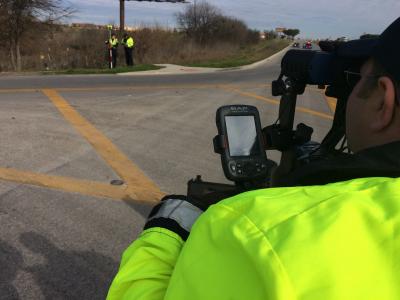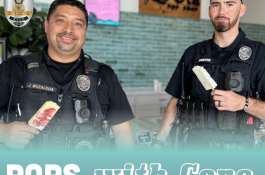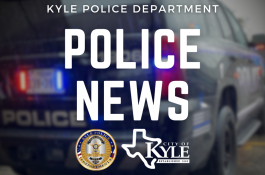KPD's Crash Team - best of the best
Lt. Andre Marmolejo of the Kyle Police Department looked on as his accident reconstruction specialists, or what he calls the “Crash Team”, began the process of recording data from a recent fatality.
Just 30 minutes prior, he handed out assignments to officers Daniel Gooding, James Jones, David Saenz and Cadet Ian Mabry at the prep meeting.
“Park your vehicles here and here,” he said, pointing to the map on the screen in the KPD headquarters.
They also covered who would have which role in the process.
On that chilly Monday morning, Kyle police officers closed down a portion of the I-35 Access road and Burleson Rd. between I-35 and Spring Branch Dr. for about two hours to reconstruct a major crash the previous Thursday that took the life of a Kyle resident.
During the reconstruction, Kyle police captured laser measurements from the accident scene. They used points on the roadways that were painted on by officers following the collision.
At about 8 p.m. Jan. 7, a Dodge Avenger driven by a 22-year-old from Buda, was traveling southbound on the I-35 access road when he struck another vehicle turning onto Burleson Rd. That driver was uninjured.
The Avenger then proceeded to hit a second vehicle, this one driven by Steve Vasquez, 33, of Kyle. That car was sitting at the stop sign waiting to turn right. Vasquez’s wife, Stephanie, 34, also of Kyle, was in the front passenger seat at the time.
Vasquez died on the scene; his wife was transported to Brackenridge Hospital in Austin with serious injuries, according to her family. The family later confirmed that she was 28 weeks pregnant at the time. According to Bridget Phelps, Stephanie’s sister, the baby is doing well.
But the family — as well as the public — wants to know what happened.
That’s where the Crash Team’s work comes into play.
Marmolejo’s team performed accident reconstruction in the hours after the collision. But a heavy fog advisory prevented them from completing the work.
“Fog and other weather factors can affect accuracy of the readings and equipment,” he said. “That’s why we came back out this morning.”
He added that coming back during the day also provides officers with a chance to see more of the crash scene than they were able to in the dark.
How does it all work?
First, officers start at the point where all the vehicles ended up following the crash. They look for visual cues such as tire marks on the road and grass, debris, felled road signs and more. In this case, a stop sign was on the ground not far from where the vehicles came to rest in the grass.
Officers then create the collision’s trajectory using paint to define each point they believe was part of the scene. They also take photos of the entire area.
Next, they use a laser measurement system.
“It’s a lot like the equipment used by construction firms when they survey a road for construction,” Marmolejo said.
A laser beam is projected against a crystal prism, which is on a tall pole. The equipment sends back the distance between the two points. All of the data captured by the equipment is also captured manually by two scribes, both police officers, who then triple-check all of the data and confirm it matches. They are also creating a map of the scene along the way to ensure everything matches.
“This way, we capture redundant data in case of technical or equipment failure,” Marmolejo said.
The process can take anywhere from 90 minutes to two hours.
“Back in the day,” Marmolejo said, “we had to come out here with tape measures and record the distance between all the points. It could take anywhere from five to six hours.”
Multiply that by the four officers and supervisor on scene — that kind of time adds up.
Marmolejo said this laser technology streamlines that process and provides extremely accurate data.
And while many officers are able to use the equipment, Marmolejo Gooding, Saenz, Jones and three other officers each have 250 hours of specialized training in accident reconstruction.
Why go through all this effort?
Marmolejo said there are several reasons.
“We want to gather as much data as we can about any serious accident or fatality,” he said. “That can help in cases where charges may be filed, for example, against a driver.”
Sometimes more importantly, he added, it’s to provide families and loved ones with details on what happened and how.
“It’s important to provide the truth so they have some closure,” Marmolejo said.
Crash scene data is combined with witness statements and information from victims. Taken in total, all that information can assist law enforcement and the district attorney by showing the cause of the crash, reckless driving and more. The resulting data and the officers’ analysis can be used by prosecutors and defense attorneys if a case goes to trial.
The specialized training involves a great deal of math and science. Kyle’s seven-person crash team received training from local experts, including a group out of Texas A&M and the collision recon unit from San Antonio Police.
“It’s pretty intense,” Marmolejo said.
“We could also get an additional training in motorcycle accidents and commercial vehicles,” he added.
Will they?
“We would like to move forward,” he said. “Our chief (Jeff Barnett) is great about getting us specialized training.”
# # #
Click here to read / view the story by Michael Perchick of KVUE News about our Crash Team.
Click any thumbnail image to view a slideshow










